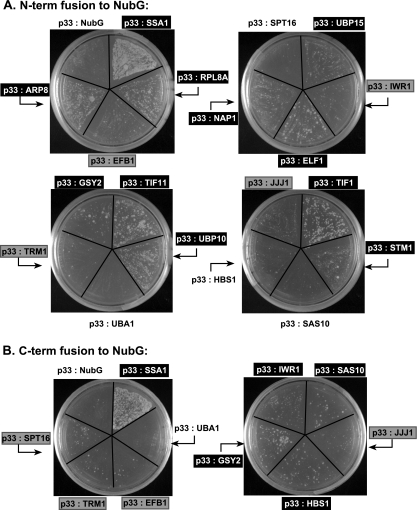FIG. 3.
Confirmation of host protein-p33 interactions via the split-Ub two-hybrid assay. (A) The full-length sequences of 19 host proteins were fused to NubG as N-terminal (N-term) fusions. Heat shock protein 70 (SSA1) was used as a positive control because it is known to interact with p33 (49). The number of colonies formed reflects the strength of protein-protein interaction. Those host factors that had positive interactions with p33 are boxed in black, whereas those with weak interactions are shown in gray boxes. Negative interactors are in boldface on a plain background. Note that the split-Ub two-hybrid assay is based on the ability of N-terminal (Nub) and C-terminal (Cub) halves of Ub to reconstitute a functional protein. A single-amino-acid mutation in Nub (NubG) reduces its affinity for Cub. However, when NubG and Cub are fused to interacting proteins they are brought to close proximity and reconstitute a functional Ub protein, which is cleaved by endogenous UBPs. This cleavage releases an artificial transcription factor, LexA-VP16, which is fused to Cub, allowing the activation of LexA-driven HIS3 and ADE2 genes in the nucleus. Unlike the yeast two-hybrid system, the split-Ub system does not require interacting proteins to be localized to the nucleus, allowing the analysis of protein interactions involving membrane-bound proteins in their natural cell location. (B) Sequences of those host proteins from panel A that interacted weakly or did not interact with p33 were fused to the C terminus (C-term) of NubG and tested for their interactions with p33 as described in the legend to panel A.

